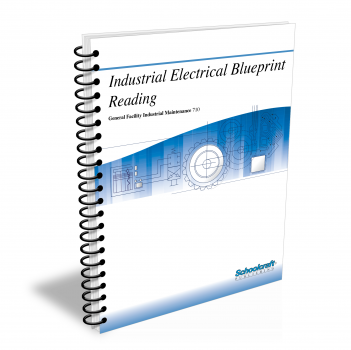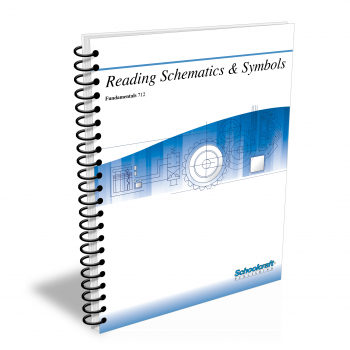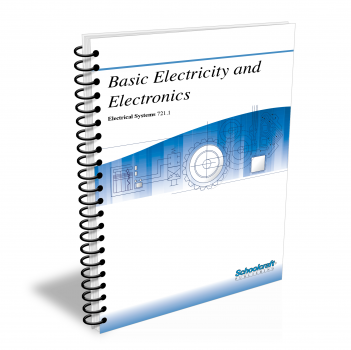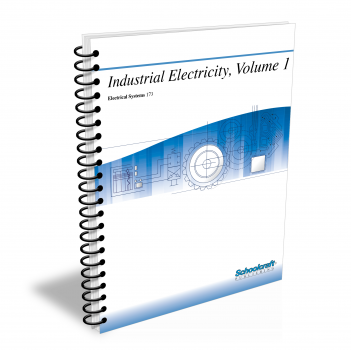Industrial Electricity Vol 2
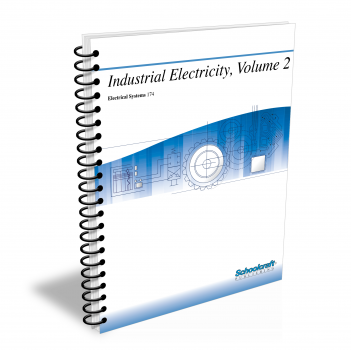
Course Number: 8174
The Industrial Electricity Vol. 2 textbook assumes a basic knowledge of the principles of electricity and focuses on the principles of three-phase circuits and motors and continues with its industry validated approach by concluding with a thorough and comprehensive explanation of electrical troubleshooting that may occur in the industrial workplace.
Does your curriculum require additional topics not included in this textbook? Build a customized version of the Industrial Electricity Vol. 2 textbook below.
Recommended Contact Hours – 23
Preview a Chapter
Available Supporting Material
- Table of Contents
- Exam Copies
- Suggested Titles
Table of Contents
Chapter 1: Principles of Three-Phase Circuits
Topics: Three-phase alternators; Y- and delta-connected alternators; Power in three-phase circuits; Load connections; Measuring power
Learning Objectives:
- List the main advantages of the three-phase ac system.
- State the definition of phase sequence.
- Demonstrate how to calculate the RMS power in a single-phase circuit.
- Explain how to measure the total power consumed by the load in a three-phase circuit.
- List the functions of an instrument transformer.
Chapter 2: Transformer Operations
Topics: Transformer designation, insulation, cooling, and polarity; Single-and three-phase transformer connections; Installing transformers
Learning Objectives:
- Name general kinds of transformers.
- List the temperature limits for each class of transformer insulation.
- Explain how oil-immersed transformers are cooled.
- Name the common methods of connecting three single-phase transformers for threephase operation.
- Explain how to select the correct location for a transformer.
Chapter 3: Principles of Three-Phase Motors
Topics: Induction motors; Squirrel-cage rotors; Pole-phase relationships; Torque, rotor speed, slip, frequency, resistance, reactance, and power factor
Learning Objectives:
- Describe a squirrel-cage rotor.
- List the factors that determine the strength of the magnetic field in an induction motor.
- Discuss pole-phase relationships.
- Demonstrate how to reverse the rotation direction of the magnetic field.
- Discuss the relationship between rotor speed and frequency.
Chapter 4: Maintaining Three-Phase Motors
Topics: Cleaning; Care of stator and rotor windings; Air gap; Overload and single-phase operation; Motor shaft currents; Bearings; Maintenance schedule
Learning Objectives:
- List the steps in measuring the resistance of the insulation on motor windings.
- Explain how to raise the temperature of a motor winding.
- List the steps in lubricating motor bearings.
- List the conditions that must exist before you can lubricate bearings.
Chapter 5: Three-Phase Motor Controllers
Topics: Limitations; Full-voltage and across-the-line starting; Reducing starting current; Primary- and secondary-resistance starters; Maintenance; Multiple start-stop controls; Across-the-line reversing starters; Plugging control; Jogging; Controlling surge and backspin
Learning Objectives:
- Explain how a motor starter works.
- Explain the difference between open transition and closed transition.
- Name the common kinds of reduced-voltage starters.
- List the steps in inspecting motor starters.
- Explain how to select the best motor starter for a particular application.
- Explain the difference between low-voltage release and low-voltage protection.
- Describe the plugging process.
- Explain how to prevent backspin.
Chapter 6: Motor Starters
Topics: Motor controllers; Controller enclosures; Starters; Magnetic controls; Interlocks, Reversing and combination starters
Learning Objectives:
- Describe the difference between a manual starter and a magnetic starter.
- Explain the function of a shading coil in a magnetic starter.
- Explain the effects of low voltage on a controller.
- State the reason why holding-circuit interlocks are required on magnetic starters and contactors.
- Demonstrate how to reverse the shaft rotation of a three-phase motor.
Chapter 7: Switches and Controls
Topics: Pushbuttons; Selector switches; Wall boxes; Contact blocks; Indicating lights; Circuit diagrams; Legend plates
Learning Objectives:
- Discuss the characteristics of industrial switches and controls.
- Identify the five most commonly used NEMA pushbutton stations.
- Demonstrate how to mount an oil-tight control station both vertically and horizontally.
- Explain the difference between standard and press-to-test indicating lights.
- Explain how a three-wire control circuit works.
Chapter 8: Control Relays
Topics: Contact operation; Mountings, enclosures, terminals, and definitions; NEMA classes; Causes of failure
Learning Objectives:
- State the definition of a relay
- Explain the function of relay contacts.
- Select the best relay for use where large movement of the contacts or high contact force is required.
- List the advantages of a reed relay.
- Tell why industrial relays usually have double-break contacts.
Chapter 9: Motor Control Centers
Topics: Features and advantages; MCC bus; NEMA standards; Enclosure construction; Wiring; Circuit protection; Installation
Learning Objectives:
- Define the term motor control center.
- Name the main advantages and disadvantages of back-to-back MCC construction.
- Explain how to install an MCC.
- Define a note, a caution, and a warning as each relates to MCC equipment.
- List the checks to conduct prior to releasing an MCC for plant operation.
Chapter 10: Troubleshooting with Electrical Schematics
Topics: Symbols; Elementary diagrams; Power control and motor-starting circuits; Identifying conductors; Control panel layout; Sequence of operation
Learning Objectives:
- Identify a control relay on an electrical schematic.
- State the NEC requirements for fuses in ungrounded conductors.
- Explain component numbering on electrical schematics.
- Explain how conductors in a motor-control circuit are identified.
Chapter 11: Troubleshooting Control Circuits
Topics: Control-circuit functions; Conditions of protection; Troubleshooting pushbutton, sequence/control, motor, and overload circuits
Learning Objectives:
- Explain how severe three-phase voltage unbalance affects a three-phase motor.
- List the advantages of inherent protection.
- Explain how undervoltage release works.
- Describe how to troubleshoot a motor circuit.
Chapter 12: Troubleshooting Combination Starters
Topics: Using relay-troubleshooting charts; Latching-relay and timing-relay checks; Replacing relay coils; Troubleshooting control circuits, starters, and relays
Learning Objectives:
- List the reasons why a magnet coil burns or short-circuits.
- List the steps in troubleshooting a defective motor.
- Explain how a mechanical latching relay works.
- Explain how an electronic timing relay operates.
Chapter 13: Troubleshooting Control Devices
Topics: Reversing controllers; Using a checking-sequence chart; Autotransformer starters; Multispeed motor starter controls
Learning Objectives:
- Demonstrate how to reverse the rotation of a three-phase induction motor.
- Explain the function of limit switches in reversing-motor applications.
- Describe how to use a checking-sequence chart.
- Select the best starter for use where it is undesirable to put a heavy load on the power supply.
- Explain how to change the speed of a squirrel-cage motor.
Chapter 14: Troubleshooting Special Controls
Topics: Selenium rectifiers; Testing rectifier diodes and three-phase rectifiers; Control-system logic; Static control; Time delay element
Learning Objectives:
- Explain the effects of age on a selenium rectifier.
- Name the protective devices used in electrical systems and pneumatic systems.
- State the definition of a bistable device.
- List the functions of a static control device.
Chapter 15: Troubleshooting AC Motors
Topics: Grounded stator windings; Short-circuited and reversed phases; Open circuits; Incorrect voltage connections
Learning Objectives:
- Identify various kinds of three-phase motor failures.
- Demonstrate how to conduct a balanced-current test on a three-phase, Y-connected winding.
- List the symptoms of a reversed phase in a three-phase winding.
- Explain how to identify external leads that have become defaced.
- Demonstrate how to test for an open circuit in a split-phase motor
Request Exam Copies
Exam Copies
Ready to see a copy of our textbooks? After selecting which textbooks you’d like to review for your course, you can submit your request by either logging in or creating an account so we know where to ship your exam copies. A representative from Schoolcraft will contact you to confirm and finish processing your request.
Exam copies are always free and yours to keep.
Selected Exam Copies
none selected
* Maximum of five copies can be ordered
